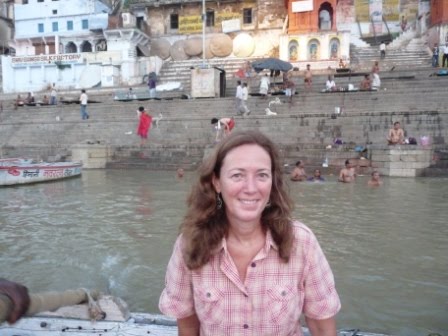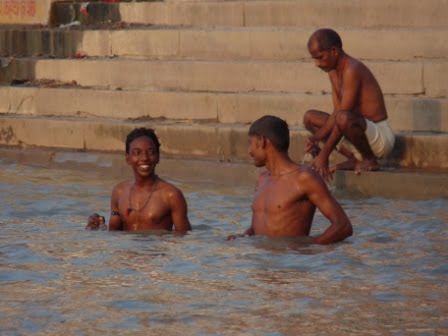Varanasi is an ancient city and perhaps the holiest city in India for Hindus. It is located at a confluence of the sacred Ganges and several other rivers. All Hindus wish to die in Varanasi to have a chance to end the cycle of reincarnation. If they aren’t lucky enough to die here, those who can afford it want to be cremated in Varanasi and have their ashes cast into the holy Ganges.
For tourists, one of the highlights of a trip to Varanasi is an early morning boat ride along the river to view the ‘ghats’, stepped platforms along the rivers edge where people come to bathe their sins away. There are about eighty ghats in Varanasi stretching for several kilometers along the river. In addition to people bathing, many others come to pray, make offerings, do yoga, wash clothes, hang out, or to sell things to people doing these other things.

We rose at 5 AM and were at the main Dasaswamedh Ghat by 5:30. We negotiated with a boat man for a one hour trip and shared the large rowboat with five people from South Korea. He rowed us up and down the river for an hour as day broke and activity commenced along the bank. The ghats of Varanasi are an unparalleled people watching opportunity. They are lively, bright, and busy places, with people of all ages participating in acts from the most mundane to the most sacred. It provides a rare glimpse into people’s private moments amid a spectacle of colourful pageantry.
There are also two burning ghats in Varanasi where Hindus are cremated. Bodies covered in brightly coloured shiny fabric and flowers are carried through the streets to the rivers edge on bamboo stretchers followed by family members. Diane and I spent an afternoon walking along the ghats and arrived somewhat unexpectedly at Harishchandra Ghat, one of the cremation ghats. We stopped to watch.
The corpses arrive at the river wrapped from head to toe in white cloth shrouds. All the work is done by outcasts called ‘doms’ who are considered unclean by other Hindus. The bodies are immersed in the Ganges before burning, then placed on piles of wood and covered with more wood. Their wrapped heads and feet stick out. Flammable liquid and powders are added, and the fires are lit using a bundle of straw. The shrouds turn brown then black as the fire rises.
There were five different cremations happening on the beach while we sat there. They were all in various stages of immolation. As the fires burned down men in bare feet with green bamboo poles pried the logs to stir the contents. No bones or skin were visible, but there was a lot of smoke and the smell of burning flesh. We sat upwind to avoid breathing it.
Male family members gathered around or sat nearby on the ghat to watch. There were no women in attendance other than Diane. The whole thing seemed very normal. It was surprisingly devoid of emotion. We didn’t see anyone crying.
We watch one corpse being rowed out into the Ganges on the bow of a boat and dumped into the water. This is the fate for those whose families can’t afford the wood required for cremation (each log is weighed to determine the total price). Yes, these bodies are dumped just upstream of the hundreds of people bathing at the ghats down river.
We were encouraged to depart by a man who claimed that we were sitting in a family-only area. He directed us to another area where he would be glad to explain what we are seeing, for a fee of course. Although this was likely a scam, we weren’t sure of the etiquette here, and didn’t want to do anything that might offend, so we decided to move on down the river.
We handled this whole scene surprisingly well. Although it was a bit disturbing, it seemed like a natural part of life here, and so it wasn’t really upsetting to see.
On a remotely related note…
Last night we were walking down a narrow dark alley when we heard a great commotion ahead. Dogs were barking and growling, people yelling, and there was a strange screaming noise. A few meters ahead we upon the scene. An Indian ‘saddhu’ (holy man) dressed in saffron robes was chasing a pack of dogs away from a small monkey that lay on the ground. It wasn’t moving. A man threw a bucket of water on the monkey, which he’d originally brought to throw on the dogs. It remained lifeless. Its monkey brethren were chattering and yelling from above, looking down on their fallen comrade. Eventually the saddhu lifted the dead monkey by the tail and removed it from the alley. The Indian people were cowering, staying back from the scene. We weren’t sure why until we passed by the crowd that had gathered. A monkey threw something down on us, just missing Diane as we scurried through. Even in the crowded lanes of Varanasi’s old city, life can be brutal and short.



Loved reading your latest blogs. Calcutta and Varanasi were two of our favourite spots in India. Great to get your perspective. Lucky you to have been able to enjoy the Durga Puja festivities!
Can't wait to hear about your adventures in Nepal…
Happy trekking!
Jan
Hi Jan — Great to hear from you. We really enjoyed Calcutta. Varanasi was one of the most interesting places, but we found the streets outside of the old city lound and congested, and the touts a bit pushy. We know that this is what we should expect from one of the most popular tourist cities in India, frequented by Indians and foreigners alike, but we were hoping it would feel a bit more holy. We're looking forward to Nepal also. We'll try to blog before and after our trek, and perhaps during??? Be well, D & P
Hi Patrick and Diane…did you say “…we were walking down a NARROW, DARK ALLEY????” I believe that you are 2 of the most courageous adventurers that I have ever personally known! …and I am so glad I know you! Fabulous insight and perspective…stay safe! Love Maureen